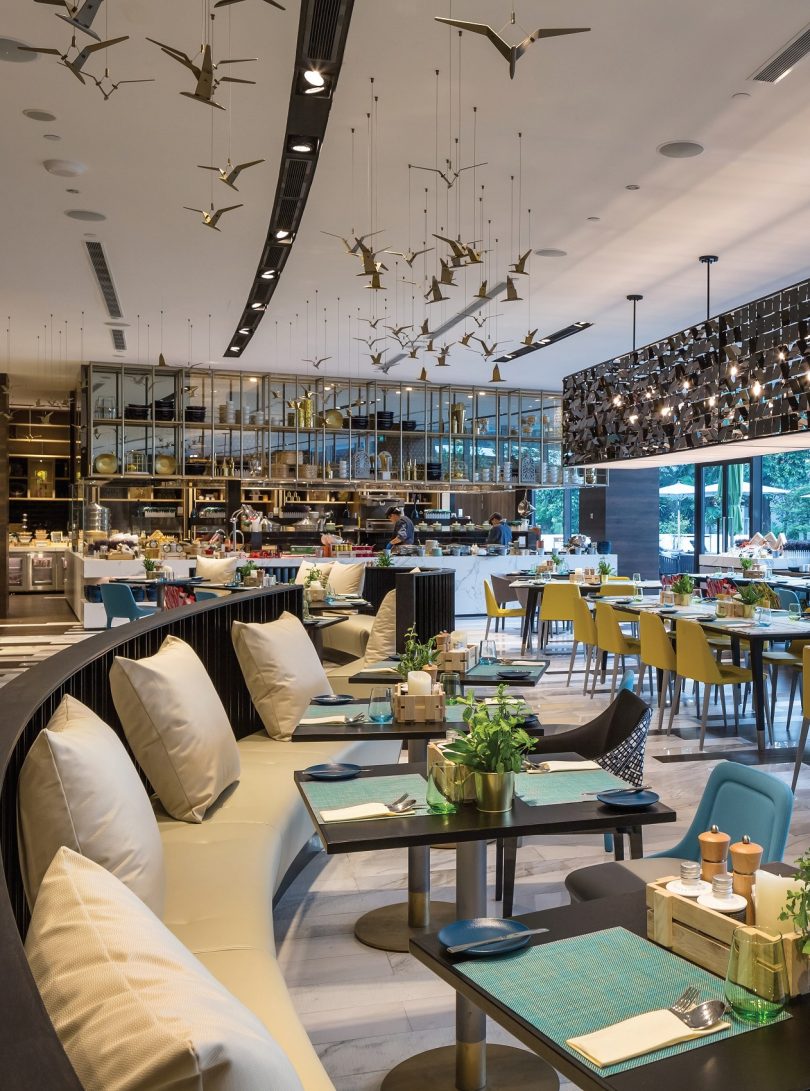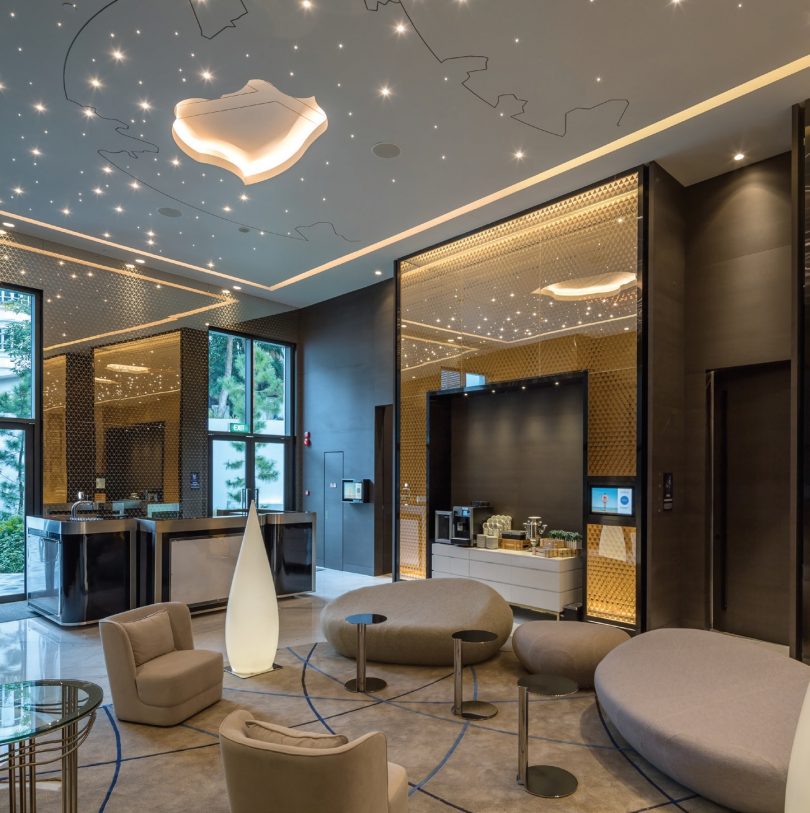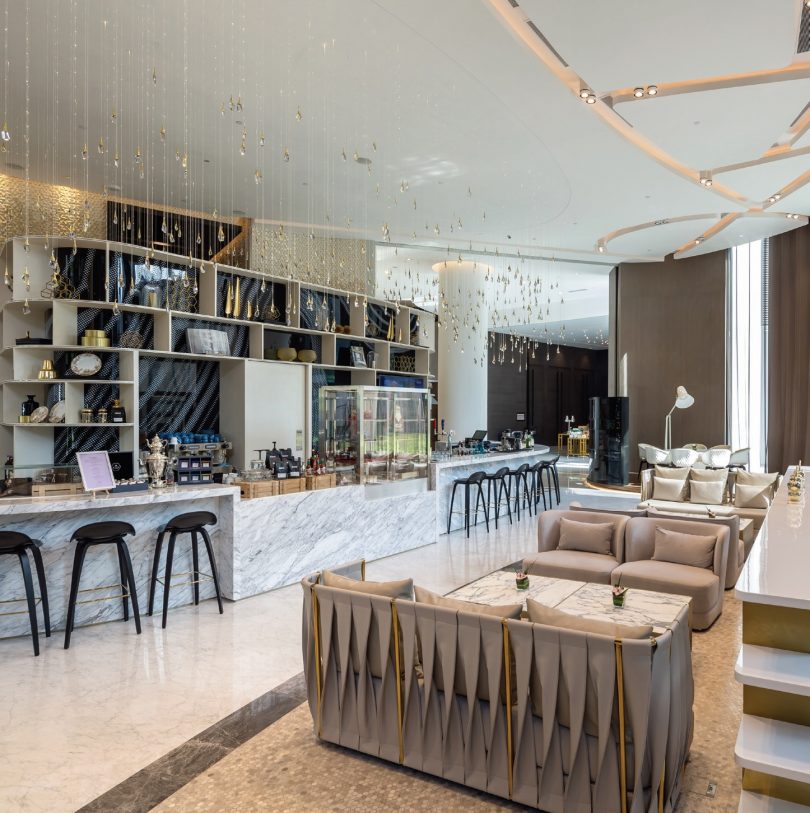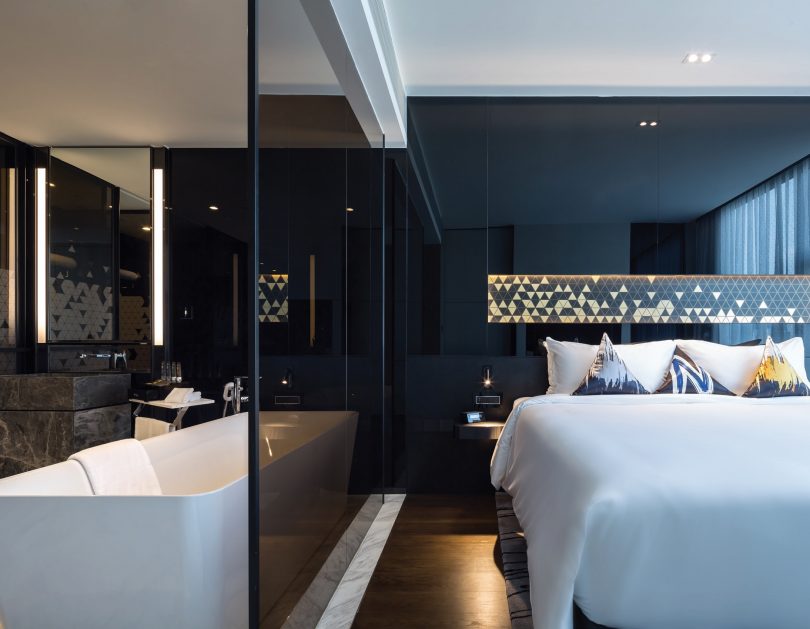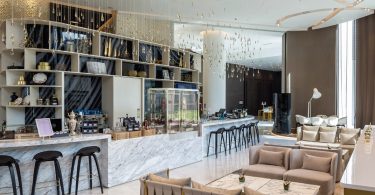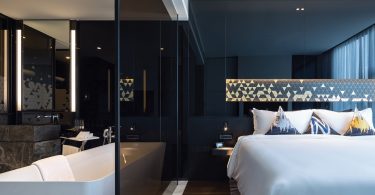
With the intention to create an integrated and cohesive development, in line with the Urban Redevelopment Authority’s (URA) vision to add value to the urban fabric along Stevens Road, the sprawling ground floor is designed to host dining, hotel functions, commercial spaces and clubhouse facilities. The design concept takes the form of a series of organic glass pods that house different programmes. These pods spill out from under the hotel tower, like pebbles sprinkled over a lawn, and engage with the surrounding urban context. This effectively draws the public into the development to enjoy the dining choices and amenities offered within.
Creeper plants form a floral crown to these pods, complementing the meadowed groundscapes; together, they create an inviting lush garden setting. Taking on an urban character that is in keeping with the surrounding Singapore skyline, the sleek glass tower housing the two hotels floats above. The distinctive sweeping wings accommodating the guest rooms take their form from the Chinese character ren (meaning people).
SPATIAL DESIGN
The ren form carves the triangular site into three distinctive public places: a grand drop-off space to the south that sets the hotel and allows for an inspirational arrival sequence; a more secluded hotel pool and courtyard space to the east; and a place for a functional sports zone to the west.
Additionally, this form allows each wing of guest rooms an optimal distance from the remaining wings, generous aspects and an efficient circulation core at its fulcrum.
AESTHETICS
As guests enter into Novotel’s lobby, they brush past the triangulation of DPD’s lobby feature wall, which is a simplification of the form: ren. The ceiling expressions reflect the stepping stones outside that have led them to this lobby. Walking through the pre-function space, they reminisce that they are under a tree canopy walking through a pine forest, with starlight above.
Arriving at the final destination, the guest room, the character that inspired the form for this entire project is revealed: ren. The guests finally understand their importance and that they are one among the many other humans who have designed, built, worked in and enjoyed this place. They are now part of the story of the hotel.
INNOVATION
Appearing as a one-stop destination that offers dining, leisure and business facilities, these spaces are cleverly designed such that they serve several functions—working spaces, informal meetings and social gatherings in a casual setting; at the same time, this creates a naturally pleasant, well-balanced environment for leisure, business and respite. Fundamentally, these designs tell stories of locality—how the development responses to its context and neighbourhood, and weaves into the existing community and social fabrics. Additionally, it creates opportunities for visitors to be an integral part of the distinctive hospitality experience.
REALISATION EFFICIENCY
The idea is to design this hotel differently from the others under the same brand and surpass current perceptions. Also, the design team was geared towards creating delightful and positive surprises for the customer through purposeful design and careful planning. This was achieved with close collaboration between architects, interior designers and landscape architects.
With limited space and footprint, room sizes and branding guidelines, Novotel Singapore on Stevens demonstrated how innovative use of space through detailed planning can transform spaces to be multipurpose, inclusive and one that encourages more social interactions. It challenges the perception of the traditional star rating system through design.
PROJECT CHALLENGES AND SOLUTIONS
The design concept has always remained the constant; the challenge was delivering this organic sculptural design, faced with environmental, budgetary and code compliance constraints.
An example is the ambitious sprawling ground floor concept. Its expansive design meant that the designers had to exceed the site coverage constraints set by the local authority. It was explained that the green public oasis, created by pulling out the pods from under the building form, would make for more spacious places, thereby resulting in positive urban amenity for the public. Hence, the excess in site coverage was accepted.
The sleek glass hotel tower with its distinctive sweeping wings, forms ren. There were concerns that this form would overwhelm the surrounding context. The suggestion was to punch holes in the façade, which would confuse the clear form and make circulation within the hotel cumbersome. The team proposed an innovative counter solution: rather than deconstruct, they softened the rear wall with landscaping.
PROJECT DATA
Project Name: Novotel Singapore on Stevens
Location: Stevens Road, Singapore
Completion Date: 2017
Client/Owner/Developer: Oxley Holdings Limited
Interior Design Firm: DP Design
Number of Rooms: 254
Lighting Consultant: WSP Consultancy Pte Ltd
Mechanical & Electrical Engineer: DP Engineering
Quantity Surveyor: Rider Levett Bucknall
Interior Fit-Out Contractor: Sunray Woodcraft Construction Pte Ltd
Images: Marc Tey by courtesy of DP Architects Pte Ltd; DP Architects Pte Ltd

 Malaysia
Malaysia Hong Kong
Hong Kong Indonesia
Indonesia Tiếng Việt
Tiếng Việt ประเทศไทย
ประเทศไทย


